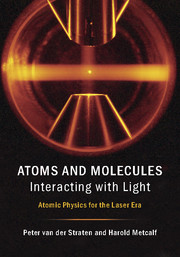Book contents
- Frontmatter
- Contents
- Preface
- Part I Atom–light interaction
- Part II Internal structure
- 7 The hydrogen atom
- 8 Fine structure
- 9 Effects of the nucleus
- 10 The alkali-metal atoms
- 11 Atoms in magnetic fields
- 12 Atoms in electric fields
- 13 Rydberg atoms
- 14 The helium atom
- 15 The periodic system of the elements
- 16 Molecules
- 17 Binding in the hydrogen molecule
- 18 Ultra-cold chemistry
- Part III Applications
- Part IV Appendix
- References
- Index
10 - The alkali-metal atoms
from Part II - Internal structure
Published online by Cambridge University Press: 05 February 2016
- Frontmatter
- Contents
- Preface
- Part I Atom–light interaction
- Part II Internal structure
- 7 The hydrogen atom
- 8 Fine structure
- 9 Effects of the nucleus
- 10 The alkali-metal atoms
- 11 Atoms in magnetic fields
- 12 Atoms in electric fields
- 13 Rydberg atoms
- 14 The helium atom
- 15 The periodic system of the elements
- 16 Molecules
- 17 Binding in the hydrogen molecule
- 18 Ultra-cold chemistry
- Part III Applications
- Part IV Appendix
- References
- Index
Summary
The Schrödinger equation is exactly solvable for hydrogenic atoms and provides excellent results for the energies and wavefunctions. For all the other atoms, the Schrödinger equation can be written down and the Hamiltonian is known exactly, but the resulting equation cannot be solved analytically. The main problem for these systems is that the electron–electron interaction does not admit the central field solutions of the hydrogen atom. The solution is intractable, and one has to resort to approximations to describe these atoms.
A special case is the alkali-metal atoms, where all but one of the electrons are in a spherically symmetric core consisting of closed shells. This one remaining valence electron determines most of the atomic properties. Since the size of the core is much smaller than the orbital radius of the valence electron, the wavefunction is concentrated outside the core, where the field is purely Coulombic and the hydrogen solutions are appropriate. Only electrons that penetrate the core are strongly affected by it, and these electrons have low orbital angular momentum ℓ.
In the nineteenth century it was discovered that the energy of the states of the alkali-metal atoms can be accurately described by the Rydberg formula when the quantum number n is replaced by an effective quantum number n∗ that differs from n by an ℓ-dependent constant denoted δℓ. The shift was named the quantum defect by Schrödinger before the advent of quantum mechanics. It is remarkable that δℓ depends only on ℓ and is nearly independent of n.
In this chapter many different techniques that are more or less standard in quantum mechanics will be used to describe the alkali-metal atoms. For each of these there is sufficient background provided to be able to understand the line of reasoning even without a formal introduction. For further details one should consult the standard textbooks on quantum mechanics. For example, a model will be introduced that can explain the physical background of the quantum defect and show how to calculate the various δℓ values from first principles. The defects will subsequently be used to calculate the energy levels and the transition rates between several states.
- Type
- Chapter
- Information
- Atoms and Molecules Interacting with LightAtomic Physics for the Laser Era, pp. 164 - 180Publisher: Cambridge University PressPrint publication year: 2016



